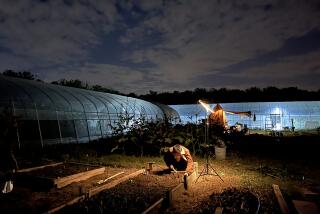Amid China’s economic transformation, many farmers struggle
Reporting from Sijiazhuang, China — Han Jin thought he had a foolproof business plan to get his family out of debt. He rented extra land next to his tiny farm here to grow heaps of cabbage at a time when the price of the leafy vegetable was soaring.
But when it came time to harvest this spring, the hapless father of two discovered thousands of other farmers had the same idea. Wholesalers were flooded with greens. Prices plummeted.
Left with a field of nearly worthless vegetables and owing more money than he earned in a year, Han locked himself in his bathroom in April and hanged himself.
The 39-year-old’s death garnered media attention across China, whose 200 million farming households are struggling to capitalize on their nation’s breathtaking economic development. While city dwellers are enjoying fast-rising living standards, much of rural China remains a hardscrabble landscape where average incomes of about $3,200 a year are less than a third of what they are in urban areas.
Still, with global food prices rising, particularly in China’s cities, conventional wisdom had it that Chinese growers must be enjoying a windfall. After all, some U.S. farmers are profiting handsomely selling pork, soybeans, nuts and other agricultural products to hungry Chinese buyers.
But in contrast to large, highly mechanized American farms, a typical Chinese farm is less than an acre in size and worked by hand. It’s a legacy of communist reform, when the state seized control of China’s farmland and subdivided it into tiny plots. Although this system has kept rural dwellers employed, it has slowed China’s ability to boost their incomes.
Chinese farmers don’t have crop insurance to protect them against disaster; government subsidies are minimal. Because they don’t own their land, growers can’t borrow against it and have little incentive to improve operations. Reliable market forecasts are hard to come by, leaving farmers to speculate about what to plant. Poor roads in many parts of the countryside force growers to sell their harvests locally or to middlemen who pocket much of the markup paid by city dwellers. Add rising costs for labor, seed, fertilizer and fuel, and many producers are seeing their profits squeezed even as retail prices soar.
“No one is going to get rich off farming,” said Scott Rozelle, an expert on China’s rural economy at Stanford University. “It’s not going to happen until farm sizes get bigger. That’s why millions of people are moving to the cities.”
Cabbage farmer Han wanted to do the same, but he was fearful because he didn’t know anyone who could find him a job. When he planted his cabbages in January here in Sijiazhuang, a speck of a village in eastern Shandong province, the wholesale price was hovering around 50 cents a pound — a figure he hoped would hold by the time he harvested in April or May.
Han was desperate to pay back $3,000 he had borrowed a year earlier to raise sheep. That plan failed when the newborn lambs mysteriously died. He tried to kill himself after Chinese New Year in February, but his wife, Han Lixiao, stopped him.
“He stopped talking,” said Han Lixiao, who now lives in an aunt’s house with her 7-year-old and 14-year-old daughters. “He was carrying a lot of pressure.”
Broad-shouldered and solidly built, Han convinced himself the solution lay in the rich chocolate-colored soil he and his wife spent years working with not much more than hoes.
Unknown to him were powerful economic forces driving up prices nationwide, creating dangerous speculative bubbles. China’s central government was flooding the economy with easy loans to blunt the effects of the global financial crisis. Flush with credit, speculators drove up prices of real estate and other assets, as well as foodstuffs including garlic, apples and tea.
Farmers quickly shifted to those products, abandoning staples such as cabbage, eggplant and cauliflower. Predictably, prices for those common vegetables rose as supplies dwindled. Rising food prices helped push China’s measure of inflation to a 28-month high in November. That month, China’s central planners appealed to farmers to plant more vegetables, especially because poor weather was compounding the nationwide shortages.
Han heeded the call, planting about 3 tons of cabbage, far more than ever before. Thousands of other growers did the same. When it came time to harvest, wholesale prices had tumbled to an unthinkable 2 cents a pound. The government did not compensate farmers.
“Everything was worthless,” said Han Lixiao, a petite woman who often struggles to hold back tears.
National media descended on the village soon after Han’s death; he had become a symbol of rural hardship. Donations poured in, some from as far away as Japan, which allowed Han Lixiao to pay off the family’s debts.
Months later, villagers in Sijiazhuang said they’re still losing money from farming. Many are relying on their grown children in cities to send more money home.
“We all suffered the same problems” as Han, said a neighbor, Han Cuixiang (no relation), standing in front of a small patch of wiry scallions next to her two-story farmhouse. “None of us are making any profit.”
Han’s widow said she’s giving up farming and will seek a job in town. Her two daughters may have to live with relatives, a thought that leaves a knot in her stomach.
“I still have years of tuition that I have to pay for,” she said. “I can’t pay for it by farming. It’s just not enough to support them.”
Tommy Yang in The Times’ Beijing bureau contributed to this report.
More to Read
Inside the business of entertainment
The Wide Shot brings you news, analysis and insights on everything from streaming wars to production — and what it all means for the future.
You may occasionally receive promotional content from the Los Angeles Times.











